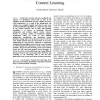6 search results - page 1 / 2 » Observing Walking Behavior of Humans Using Distributed Pheno... |
SAINT
2008
IEEE
15 years 1 months ago
2008
IEEE
The utility of walking parameters such as stride length, cadence and gait velocity for monitoring motor functions of patients suffering from brain injury, Parkinson’s disease an...
ISVC
2009
Springer
15 years 1 months ago
2009
Springer
Abstract. We present an approach for articulated motion detection and pose estimation that uses only motion information. To estimate the pose and viewpoint we introduce a novel mot...
ETRA
2006
ACM
15 years 1 months ago
2006
ACM
Next-generation immersive virtual environments and video games will require virtual agents with human-like visual attention and gaze behaviors. A critical step is to devise effic...
CORR
2004
Springer
14 years 7 months ago
2004
Springer
Social insect societies and more specifically ant colonies, are distributed systems that, in spite of the simplicity of their individuals, present a highly structured social organi...
MIDDLEWARE
2005
Springer
15 years 20 days ago
2005
Springer
Cooperative peer-to-peer (p2p) applications are designed to share the resources of participating computers for the common good of all users. However, users do not necessarily have ...

